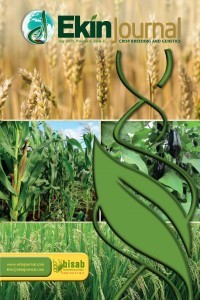Evaluation of Aonla Varieties Under Semi-Arid Conditions of Haryana
Evaluation of Aonla Varieties Under Semi-Arid Conditions of Haryana
Aonla or Indian gooseberry (Phyllanthus emblica), varieties growth, yield and quality, plant volume, fruit shape, variability,
___
- AOAC, (2000). Official methods of analytical chemist, international, 17th ed. Washington DC.
- Anonymous, (2016). Guidelines of PPV& FRA for the conduct of test for distinctiveness, uniformity and stability on Indian gooseberry (Emblica officinalis Gaertn.). Plant Var. J. India, 10(2).
- Bose TK and Mitra SK, (2001). Fruits, tropical and subtropical. Naya Udyog, Calcutta pp:523-540.
- Chadha KL, (2013). Handbook of horticulture. 12th ed. ICAR New Delhi pp:140-142.
- Fisher RA, (1958). The genetical theory of natural selection, 2nd ed. New York: Dover Publications.
- Ghosh SN, Roy S and Bera B, (2013). Study on performance of aonla cultivars in laterite soil of West Bengal. J. Crop and Weed, 9(2):36-38.
- Kumar M, Singh S and Yadav VK, (2013). Arid Fruits: Post harvest handling and Processing (in) Emerging Science and Technology for Food, Agriculture and Environment (Ed. Sandeep Kumar, Pawan Kumar Yadav and Sunil Kumar). Published by Agrobios (International). pp:435-448.
- Kumar S, Chittiraichelvan R and Karunakaran G, (2011).Performance of aonla cultivars for yield and physico-chemical properties under Coorg conditions. Indian J. Hort., 68:268-69.
- Mahajan RK, Gangopadhyay KK, Kumar G, Dobhal VK, Srivastava U, Gupta PN and Pareek SK, (2002). Minimal descriptors agri-horticultural crops: fruit crops. National Bureau of Plant Genetic Resources; New Delhi.
- Malshe KV, Salvi BR and Gawankar MS, (2016). Evaluation of different varieties of Aonla (Emblica officinalis Gaertn) under hard lateritic rocky conditions of South konkan coastal zone of Maharashtra. New Agriculturist, 27(1):135- 138
- Nagar S, Kumar M, Kumatkar RB, Sharma JR and Singh S, (2017).Evaluation of Bael (Aegle marmelos Corr.) Germplasms for Seed and Qualitative Characters under Semi-Arid Conditions of Haryana. Int. J. Pure App. Biosci., 5 (3):436-442.
- Panse VG and Sukhatme PV, (1985). Statistical methods for agricultural workers. 4th ed. ICAR, New Delhi.
- Sheoran OP, Tonk DS, Kaushik LS, Hasija RC and Pannu RS, (1998). Statistical software package for agricultural research workers. Recent advances in information theory, statistics and computer applications by D.S. Hooda and R C Hasija Department of Mathematics Statistics, CCS HAU, Hisar
- Singh S, Kumar M, Sharma JR and Baloda S, (2017). Performance of aonla cultivars for growth, yield and physic-chemical attributes under semi-arid conditions. J. Agric. Technol., 4(1) : 20-22.
- ISSN: 2149-1275
- Yayın Aralığı: Yılda 2 Sayı
- Başlangıç: 2015
- Yayıncı: Bitki Islahçıları Alt Birliği
Ajay VERMA, Ramesh Pal Singh VERMA, Jogendra SINGH, Lokendra KUMAR
Transgenics for Improving Salt Stress Tolerance in Legume Crops Chickpea and Pigeon Pea
Pushpa KHARB, Rinku CHAUDHARY, Nita LAKRA, Rishi Kumar BEHL
Stability Analysis of Fodder Cowpea Genotypes under Different Environments
Mahamaya BANIK, Nılanjaya NILANJAYA, Vinay Kumar SHARMA
Registration of "Onur01" Chickpea (Cicer arietinum L.) Variety
Dürdane MART, Meltem TÜRKERİ, Derya YÜCEL ÇETİN
Evaluation of Aonla Varieties Under Semi-Arid Conditions of Haryana
Mukesh KUMAR, Rajesh Kumar ARYA, Manoj KUMAR, Ram Karan GAUR, Sushil SHARMA
Registration of "MASS 1001" Tomato (Solanum lycopersicum L.) Variety
Sevgi MUTLU, Mehmet Asım HAYTAOĞLU, Seyfullah BİNBİR, Ayşe KAHRAMAN
Rajesh Kumar ARYA, Vandana VANDANA, Gajraj Singh DAHIYA, Ravi KUMAR, Jhabar Mal SUTALIYA, Pawan KUMAR, Mukesh KUMAR
Hanuman Lal RAIGER, Satish Kumar YADAV, Rajesh Kumar ARYA, Bijender Singh PHOGAT
Dürdane MART, Meltem TÜRKERİ, Ramazan AKIN, Evren ATMACA, Süreyya Emre DUMRUL, Nejda ÇANKAYA, Ayşe Gülgün ÖKTEM, Derya YÜCEL, Tolga KARAKÖY, Sezgin MART, Adem Emin ANLARSAL
